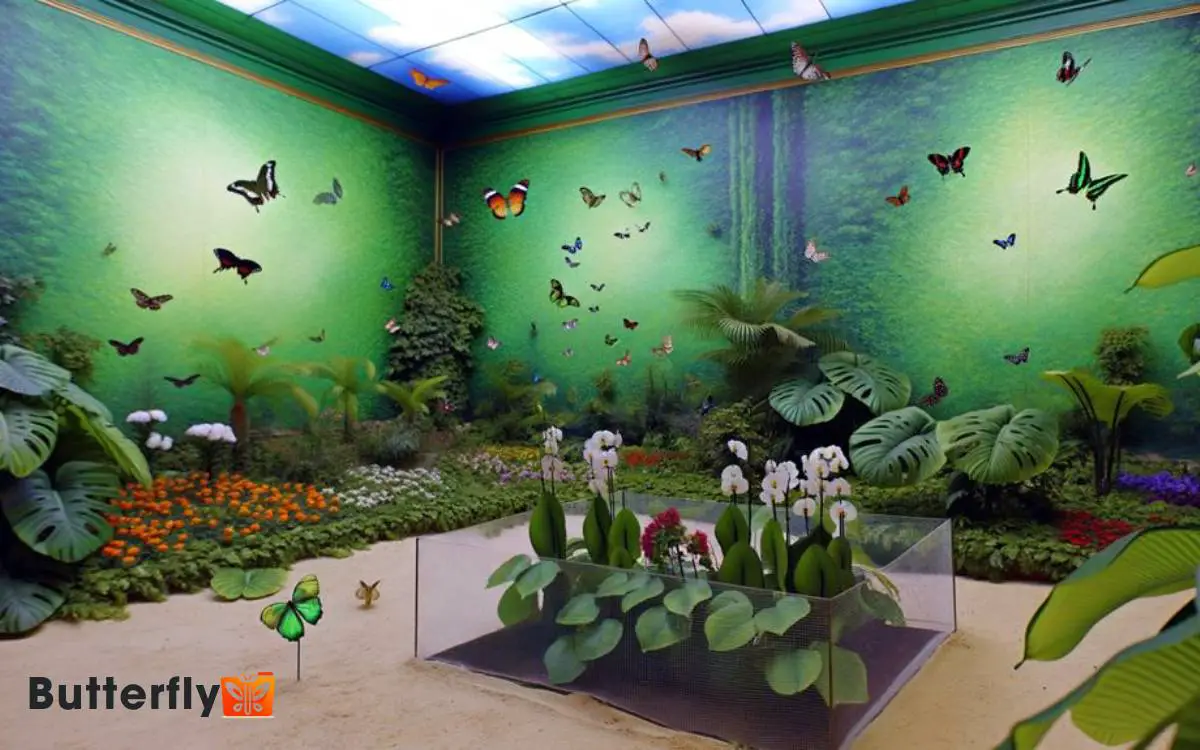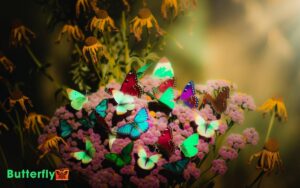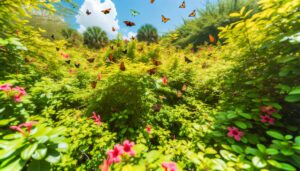Can You Have Butterflies as Pets? Yes!
Yes, you can keep butterflies as pets, but it’s essential. You need to understand their lifecycle: eggs, larvae, caterpillars, chrysalis, and adult butterflies. Create an enclosure with ample space, appropriate temperature, and humidity.
Ethically, consider their ecological role and the challenge of replicating their natural environment in captivity.
Instead, fostering a butterfly-friendly garden can be an effective and environmentally friendly alternative. Explore specific care details and ethical considerations for better-informed decisions.

Key Takeaways
Understanding Butterfly Lifecycles
To fully appreciate butterflies as pets, you need to understand their complex lifecycles, which include the stages of egg, larva, pupa, and adult. Each stage presents unique challenges and wonders, from the tiny, delicate eggs to the transformative pupal stage where the butterfly emerges in all its beauty. Many people see butterflies as a sign from God, symbolizing renewal, hope, and the soul’s journey. Raising butterflies as pets allows you to witness this miraculous process firsthand, deepening your appreciation for nature’s intricate design.
Initially, a female butterfly lays eggs on host plants, carefully selecting species that will provide nourishment for the emerging larvae. The egg hatches into a larva, or caterpillar, which focuses on consuming plant material to grow rapidly.
Following this, the caterpillar enters the pupal stage, forming a chrysalis where it undergoes metamorphosis. Inside the chrysalis, the caterpillar’s body transforms, reconfiguring into an adult butterfly.
Habitat Requirements
When setting up a butterfly habitat, you’ll need to take into account the size of the enclosure, as it must provide ample space for movement.
Maintain the correct temperature and humidity to mimic their natural environment and guarantee their health.
Additionally, supply appropriate food and water sources to meet their nutritional needs.
Enclosure Size Matters
Ensuring butterflies thrive in captivity hinges on providing an enclosure that’s spacious enough to accommodate their flight patterns and natural behaviors.
You should aim for a minimum of 24 inches in height, width, and depth to allow ample room for movement. Butterflies need vertical space to fly upwards and horizontal space to explore.
Include mesh sides to facilitate air circulation and prevent wing damage. Planting nectar-rich flowers inside the enclosure mimics their natural habitat, offering both food and shelter.
Additionally, avoid overcrowding; a general rule of thumb is no more than one butterfly per square foot.
Temperature and Humidity
Maintaining ideal temperature and humidity levels is crucial for creating a suitable habitat for butterflies, as these factors directly influence their metabolism, activity, and overall health. Aim for temperatures between 75-85°F (24-29°C) and humidity levels around 60-80%.
Here’s a guide to help you achieve these conditions:
- Temperature Control: Use a thermometer to monitor and adjust the temperature using heaters or fans as needed.
- Humidity Management: Employ a hygrometer to measure humidity. Mist the enclosure with water or use a humidifier to maintain proper moisture levels.
- Ventilation: Ensure good airflow to prevent mold and maintain healthy air quality.
- Lighting: Provide 12-14 hours of light daily, using UV lamps to mimic natural sunlight.
Keeping these parameters stable guarantees a thriving butterfly habitat.
Food and Water
Proper temperature and humidity are just part of the equation; butterflies also require specific food and water sources to thrive in their habitat.
You’ll need to provide nectar-rich flowers like milkweed, lantana, or verbena, which serve as primary food sources.
Additionally, you can supplement their diet with a homemade nectar solution mix one part sugar with four parts water. Make sure the solution is changed regularly to prevent fermentation.
For hydration, butterflies benefit from shallow water dishes or damp sponges placed in the enclosure, mimicking natural puddles they drink from. Avoid deep containers to prevent drowning.
Feeding Butterflies
To keep your butterflies healthy and vibrant, you’ll need to provide them with a diet rich in nectar, which can be sourced from fresh flowers or a homemade sugar solution.
Here are some detailed steps to make certain their nutritional needs are met:
- Nectar Source: Use fresh flowers like milkweed, marigold, or zinnia. These have high nectar content suitable for butterflies.
- Homemade Solution: Mix one part sugar with four parts water. Guarantee the solution is well-dissolved and free of contaminants.
- Feeding Dish: Use a shallow dish or sponge soaked in the sugar solution to mimic a natural feeding environment.
- Frequency: Replace the nectar daily to prevent fermentation and ensure freshness.
Health and Well-being
To guarantee your butterfly’s health and well-being, you need to maintain proper habitat conditions.
This includes providing a suitable habitat with appropriate temperature, humidity levels, and access to sunlight. Consistent monitoring of their diet and lifespan is also essential to provide ideal care.
To ensure your butterfly’s health, it is important to provide daily nutritional needs. Understanding their lifespan and care requirements will further contribute to their overall well-being.
Proper Habitat Conditions
Creating an ideal habitat for pet butterflies necessitates careful attention to temperature, humidity, and light conditions, taking into account their health and well-being. Butterflies thrive in specific environmental conditions that mimic their natural habitat.
Here are four key factors to take into account:
- Temperature: Maintain a range of 75-85°F to guarantee metabolic and developmental processes occur efficiently.
- Humidity: Keep the humidity level between 60-80% to prevent dehydration and facilitate proper wing expansion after emergence.
- Light: Provide 12-14 hours of light daily using natural sunlight or full-spectrum artificial lighting to support their diurnal activity patterns.
- Ventilation: Ensure good air circulation to prevent mold growth and reduce the risk of respiratory issues.
Daily Nutritional Needs
Nourishing your butterflies with the right diet is as vital as maintaining their habitat, guaranteeing they receive essential nutrients for peak health and longevity. Adult butterflies primarily feed on nectar from flowers, so provide a diverse range of nectar-rich plants.
You can also supplement their diet with a homemade nectar solution made of water and sugar. Make sure the sugar concentration mimics natural nectar, about 10-20% sugar by volume.
Additionally, offer fruit slices like oranges and bananas, which supply essential vitamins and minerals.
Hydration is important, so maintain a shallow water source. Remember to avoid pesticides and chemicals on all food sources. By meeting these nutritional needs, you’ll support their overall health and promote vibrant, active butterflies.
Lifespan and Care
Guaranteeing the health and well-being of your butterflies requires a thorough understanding of their lifespan and specific care needs. Most butterflies live for only a few weeks, but this can vary by species.
To care for them effectively, follow these guidelines:
- Habitat: Provide a spacious, ventilated enclosure with access to natural light to mimic their natural environment.
- Diet: Offer a variety of nectar-rich flowers or a homemade nectar solution to guarantee proper nutrition.
- Temperature: Maintain an appropriate temperature range, typically between 70-85°F, to support their metabolism and activity levels.
- Humidity: Ensure a humidity level of around 60-80% to prevent dehydration and facilitate proper wing development.
Breeding Considerations
When breeding butterflies, it’s essential to comprehend their specific environmental needs and reproductive cycles in order to guarantee successful propagation.
Each species has unique requirements for temperature, humidity, and light. Make sure you mimic their natural habitat by maintaining appropriate conditions.
Female butterflies need host plants to lay eggs on; research the preferred plant species for your butterfly type. You’ll also need a continuous source of nectar and food for larvae.
Monitor the developmental stages from egg to adult, adjusting environmental factors as needed. Proper ventilation and cleanliness are crucial to prevent disease.
Legal Regulations
Before acquiring butterflies as pets, it’s crucial to familiarize yourself with the legal regulations surrounding their ownership and breeding. Various jurisdictions have specific rules to protect local ecosystems and prevent the spread of non-native species.
Here are some key points to keep in mind:
- Permits: Some regions require permits for owning or breeding certain butterfly species.
- Endangered Species: Check if the species you’re interested in is protected under local or international laws.
- Import/Export Restrictions: Regulations may control the movement of butterflies across borders to prevent ecological disruption.
- Local Guidelines: Always consult local environmental authorities to guarantee compliance with regional rules.
Understanding these regulations will help you responsibly and legally enjoy keeping butterflies as pets.
Ethical Implications
While adhering to legal regulations is important, it’s equally important to contemplate the ethical implications of keeping butterflies as pets.
Butterflies have complex ecological roles, including pollination and serving as food for other species. Capturing them disrupts natural ecosystems and affects biodiversity.
Additionally, butterflies have specific habitat and dietary needs that are challenging to replicate in captivity, potentially leading to stress and shortened lifespans.
You should consider whether the confinement of butterflies for personal enjoyment justifies the potential harm to their well-being and the environment.
Ethically, it’s vital to evaluate if captivity aligns with their natural behaviors and life cycles. Reflecting on these factors can guide responsible decisions regarding butterfly conservation and preservation.
Alternatives to Keeping Butterflies
Instead of keeping butterflies in captivity, you can create a butterfly-friendly garden that supports their natural behaviors and life cycles. By providing the right environment, you’ll attract butterflies and help them thrive.
Here are some steps to contemplate:
- Plant Native Flowers: Select a variety of native flowering plants that bloom at different times to provide a continuous nectar source.
- Provide Host Plants: Caterpillars need specific host plants to feed on. Research which plants cater to local butterfly species.
- Avoid Pesticides: Pesticides can harm butterflies at all life stages. Opt for natural pest control methods.
- Create Shelter: Include shrubs, trees, and other structures to offer protection from predators and harsh weather.
Conclusion
Keeping butterflies as pets is a complex endeavor requiring detailed knowledge and careful consideration. You’ll need to understand their lifecycle, habitat, and feeding needs to guarantee their health and well-being.
Surprisingly, only about 10% of butterfly species are suitable for captivity. Always check legal regulations and consider ethical implications. If you’re unsure, alternatives like butterfly gardening can offer similar joys without the challenges of keeping them as pets.






Unlike steroids, HGH affects the physique more subtly, with advantages accumulating over
longer periods. For some men, the answer to higher erectile capabilities and satisfying intercourse might lie in remedy with supplemental testosterone or
human progress hormone. Penis dimension may be
something you need to reside with once you attain your mid-twenties, but that doesn’t need to forestall
you from having a fantastic sex life.
It could help males with issues like getting an erection, and can also enhance women’s sexual perform, however it is not FDA-approved for this use.
As A Result Of the physique’s HGH ranges naturally lower with age,
some so-called anti-aging experts have claimed that HGH merchandise could reverse the age-related decline of the physique.
Human development hormone (HGH), additionally referred to as somatotropin, is a hormone that the pituitary gland, which is in regards to the measurement of
a pea and found at the base of your brain, makes and releases.
These medicine work by stimulating protein synthesis and increasing muscle mass.
On the opposite hand, anabolic steroids can have even more extreme opposed reactions, similar to testicular atrophy,
infertility, gynecomastia, liver failure, and others.
But, most steroids aren’t legally out there as they are not manufactured for human use.
Human development hormone, or HGH, is of course produced in our bodies by
the pituitary gland. As its name suggests, it plays a
vital position in childhood development, impacting height and bone development.
HGH continues to influence our our bodies throughout
maturity, influencing muscle mass, physique fats distribution, and even power levels.
You can be taught more about tips on how to increase
HGH naturally via way of life modifications and other
strategies. For specific details about HGH, WebMD presents a complete useful resource.
However, it’s worth noting that sure international locations have more lenient laws regarding using performance-enhancing substances.
In Mexico and Thailand, anabolic steroids are legal and
may be bought over the counter without a prescription.
Most crimes are prosecuted at the state degree,
but each state and federal crimes are typically charged as felony offenses.
Nevertheless, these individuals weren’t charged with steroids crimes, but instead were
charged with perjury, the crime of lying when under oath or affirmation. Criminal investigations
for any steroid crime can lead to expenses of perjury
or making false statements to investigators even when the suspect isn’t charged with a steroids crime.
The purpose why are steroids good a higher physique temperature is linked to steroid-use is because steroids spike your
blood pressure due to them growing testosterone levels.
An enhance in testosterone results with an increase in LDL levels
(the unhealthy sort of cholesterol). As a result blood pressure spikes and the next body temperature often follows.
Cortisol, aldosterone and different intercourse hormones
are also steroids, although they lack the anabolic results of
androgens. Due To This Fact, the growth hormone has a protein construction, and it’s categorized as a peptide
that has nothing in common with steroids. The only FDA-approved form of artificial HGH
comes as a shot, and you will get it only by prescription. You may see HGH products – or merchandise
that claim to extend your body’s manufacturing of HGH – in the type of tablets and sprays.
These are not accredited by the FDA, and the Federal Trade Fee has seen no dependable evidence to assist the claim that these
products have the identical effects as prescription HGH.
Thanks to this method, the treatment can match the structure
of the natural human growth hormone. All HGH brands can be found
only as subcutaneous injections due to their peptide structure.
Instead, steroid hormones are produced by the adrenal glands, in addition to the testes in males and
the ovaries in women. Normally, the secretion of steroid
hormones follows a day by day or monthly sample. Furthermore,
the world anti-doping agency (WADA) has banned HGH in sports activities, alongside different PEDs
corresponding to anabolic steroids (AAS). In one study, researchers discovered that in a 24-hour fast, the quantity of vitality your physique makes use of throughout varied actions dropped,
whereas growth hormone levels rose by so much.
Studies show that synthetic human growth hormone may increase
sexual efficiency.
They have a typical steroid structure made of 4 rings of
carbon atoms. Oral tablets and tablets with HGH might be simply deactivated by
your gastrointestinal system, while HGH gels won’t get absorbed by way of your pores and
skin. The enhance happens in about 4 to 12 weeks
if you’re on the right food plan and with discipline in your training sessions.
Typically the transformation is so spectacular that the user looks photoshopped in footage.
However don’t be deceived by the sheer muscle dimension, generally they aren’t
as strong and highly effective as they give the impression of being.
Now that you understand the distinction between the 2 enhancers let us now
take you through certain things that make both of them stronger than the other.
In Brazil, anabolic steroids are authorized, however their purchase
requires a prescription from a licensed doctor [51]. The authorized standing of different performance-enhancing substances, such as progress
hormones and insulin, additionally varies from country to nation.
In the Usa, growth hormone is authorized only with a prescription for particular medical
conditions. In distinction, it is legal for anti-aging purposes in some European countries, like Germany and France.
Similarly, insulin is legal only with a prescription in most
international locations, however in others, like the UK and
Canada, it might be purchased over-the-counter and not using
a prescription [52]. The use and possession of performance-enhancing substances
such as anabolic steroids, progress hormones, insulin, and
diuretics are regulated differently worldwide.
HGH is an anabolic hormone used for decades as a performance-enhancing agent in sports activities.
When it’s used over time, the hormone can increase urge for food and improve your
capacity to gain weight. In general, an grownup human male produces
about eight to 10 instances extra testosterone than their female counterparts.
Regular testosterone ranges in the bloodstream are about 359 and 1230 nanograms.
Additionally known as the “dopamine bean,”
Mucuna Pruriens accommodates extraordinarily excessive concentrations of L-DOPA, a precursor to dopamine
that leads to the release of HGH. Mucuna Pruriens can also be a crucial cortisol balancer (the stress hormone), mood lifter, and sleep inducer,
and it naturally will increase levels of testosterone. One of the Andes’ most popular adaptogens, Maca Root, helps to control the pituitary launch of HGH.
It increases energy, maintains libido, and shuns fatigue—making it
a great place to begin out natural hormone replacement.
The supplement is a strength supplement that reinforces power ranges, reduces
fatigue, and improves exercise efficiency.
These days, some of the popular HGH kits is Riptropin, a rebranded generic HGH
recognized to be of high of the range. It comes from China, so you’ll
want to ensure you get the proper product and that it’s not
counterfeit utilizing this model name. If you probably can supply legit Riptropin, you’ve found a excessive quality
generic and probably saved a few dollars, too. The expense of manufacturing HGH leads the labs to
take shortcuts to make sure their earnings.